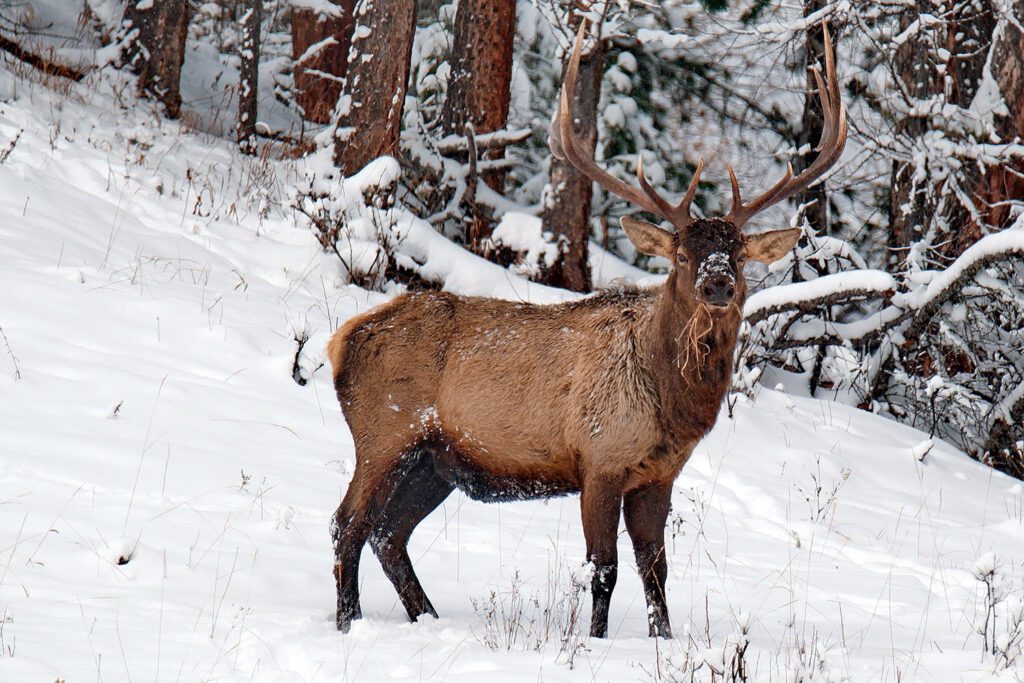A relative of the red deer
The Tian Shan maral is a subspecies of wapiti, Cervus canadensis. This relative of the red deer is distributed through North America, Siberia, and in the high mountains of Central Asia. They are the second largest member of the deer family, exceeded only by the moose. In biology, the maral is adapted to live in open plains and harsh cold climates. During the rut, males grow large antlers and advertise with a loud bugling call designed to carry over long distances. Maral, or wapiti, are listed as Least Concern in the IUCN Red List, but the Tian Shan maral subspecies has not been evaluated and may be more threatened.
|
Flagship species |
IUCN Red List (<year of assessment>) |
KAZ Red Book (1999) |
KGZ Red Book (2006) |
TJK Red Book (2015) |
Approx. population size in the project region |
|
Tien Shan Maral Cervus canadensis songaricus |
Least Concern (2015) |
Not listed |
Listed |
N/A |
1,700 (KAZ) 800 (KGZ) |
Distribution and habitat
Preferring cold grasslands, open woodlands, meadows, and open mountainous regions, the maral is found on the high plateaus of Outer Mongolia, southern Siberia, and the Altai and Tian Shan mountains in Kazakhstan, Kyrgyzstan, Russia, and China. During summer months, it spends time in alpine meadows, while in winter it moves into valleys away from deep snow. Seasonal migration may be as much as 140 km in the Altai and Sayan Mountains.
In Kazakhstan, the Tian Shan maral occurs in the eastern parts of Northern Tian Shan range and in the Jongar Alatau range. The maral in the Altai mountains belongs to the Siberian maral, possibly distinctive from Tian Shan maral at the subspecies level. In Kyrgyzstan, the Tian Shan maral is found in the Kungay Alatoo range (Chon Kemin National Park and Chon Kemin community-based conservancy) and the Terskey Ala Too range (Ak-Suu region), as well as in and around Naryn reserve. Tian Shan maral mainly inhabit coniferous and mixed tree forests, which may be an adaptive behaviour to poaching pressure. Other maral or wapiti species prefer grasslands above the forest belt as summer habitat and riparian areas as well as semi-desert, steppe and shrubland on sites with little snow as winter habitat.

Importance
Grazing animals have an important role within ecosystems by maintaining vegetation structures. Cyclic grazing ensures that vegetation growth is controlled while also providing important ecosystem processes, such as increasing nitrogen availability for plants. When large herbivores roam the landscape they transport seeds through their fur and excrement, as well as leaving nutrient hotspots for vegetation growth in the form of carcasses. A decrease in grazing animals within an ecosystem could lead to changes in vegetation structure and species composition, ultimately changing the ecosystem. The preference of the maral for forests, as observed in Central Asia and likely caused by poaching, may affect the natural rejuvenation of these forests and contribute to their degradation. Maral are also an important prey species for predators such as snow leopards, brown bears, and wolves.

Threats
The Tian Shan maral is affected by seasonal variations in temperature and precipitation and extreme climatic conditions. Changes in the rate of precipitation causes alterations in wet and dry periods and may lead to low resource availability resulting in weight loss or forcing the animals to migrate. They can also be affected by increasingly extreme climatic conditions such as severe cold or droughts which limits forage availability and accessibility. As a large-bodied animal, Tian Shan maral may be affected by heat stress. Likewise, certain parasites, such as horse flies, are more active during warm periods. This effect can be exacerbated where cooler areas are not available for them to take refuge. Habitat loss and fragmentation are also considered as threats to the maral, increasing in risk with human disturbances, poaching and competition with livestock.
The meat and body parts of the maral are highly valued. In Kazakhstan, maral are used for regulated sport hunting tourism, which incentivizes their protection. In Kyrgyzstan, nature tourism opportunities foster their protection by a community-based NGO in Chon-Kemin. Where incentives are not available to protect marals, they are left vulnerable to poaching. In addition, introduction of the non-native maral from the Altai threatens the genetic integrity of the Tian Shan maral.
Mattioli, S. 2011. Family Cervidae (Deer). In: D.E. Wilson and R.A Mittermeier (eds), Handbook of the mammals of the world, pp. 350-443. Lynx Edicions, Barcelona.
Dangal, S. R. S., Tian, H., Lu, C., Ren, W., Pan, S., Yang, J., … Hessl, A. (2017). Integrating herbivore population dynamics into a global land biosphere model: Plugging animals into the earth system. Journal of Advances in Modeling Earth Systems, 9, 2920– 2945. https://doi.org/10.1002/2016MS000904
Brook, S.M., Pluháček, J., Lorenzini, R., Lovari, S., Masseti, M., Pereladova, O. & Mattioli, S. 2018. Cervus canadensis (errata version published in 2019). The IUCN Red List of Threatened Species 2018: e.T55997823A142396828. https://dx.doi.org/10.2305/IUCN.UK.2018-2.RLTS.T55997823A142396828.en. Accessed on 03 November 2022.
